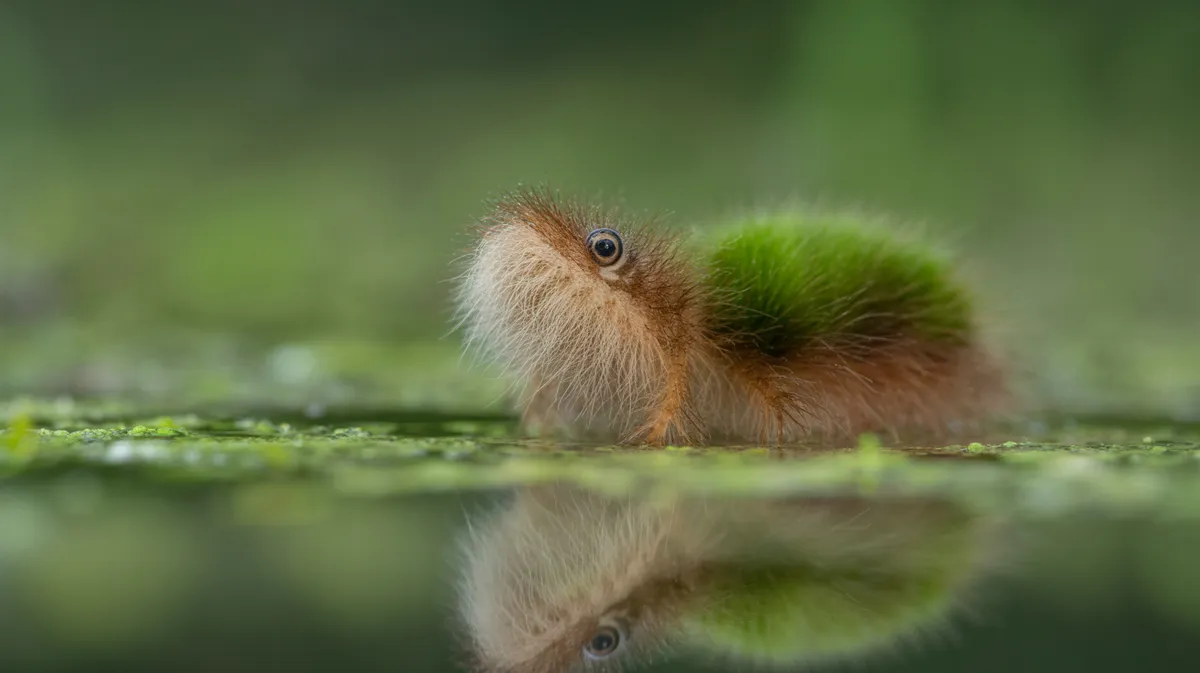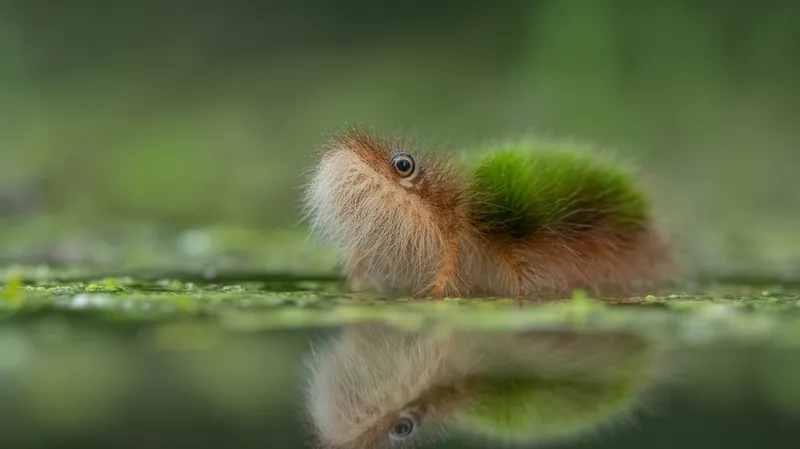
Moss Animal
Cristatella mucedo

Meet the Moss Animal
The moss animal, also known as Cristatella mucedo, is a freshwater bryozoan that forms gelatinous, moss-like colonies attached to submerged surfaces. These colonial invertebrates consist of hundreds to thousands of tiny zooids working together to filter microscopic food particles from the water. Moss animals are most commonly found in ponds, lakes, and slow-moving streams, where they often appear as translucent, jelly-like masses. Their unique locomotion allows entire colonies to glide slowly over surfaces using muscular contractions.
Classification
Invertebrate
Habitat
Freshwater
Diet
Filter feeder
Lifespan
Several weeks to a few months (colony lifespan)
Conservation
Least Concern
Weight
Up to 500 grams (colony mass)
📖Fascinating Facts
Jelly-Like Colonies
Moss animal colonies often appear as gelatinous, translucent masses attached to plants or rocks underwater.
Filter Feeding
Each zooid uses a crown of tentacles called a lophophore to filter plankton and organic particles from the water.
Winter Survival
Moss animals produce statoblasts—tiny, durable pods that survive winter and harsh conditions to regrow when favorable.
📋Detailed Description
Cristatella mucedo, commonly known as the moss animal, is a colonial freshwater bryozoan belonging to the class Phylactolaemata. Colonies are typically elongated, flexible, and gelatinous, often measuring up to 15 cm in length, though individual zooids are only about 1 mm each. The colony is composed of hundreds to thousands of genetically identical zooids, each housed in a transparent, mucilaginous matrix. Zooids possess a horseshoe-shaped lophophore, a crown of ciliated tentacles used for filter feeding. The colony is capable of slow, coordinated movement across submerged surfaces via muscular contractions of the basal 'foot,' a unique trait among bryozoans. Cristatella mucedo thrives in cool, well-oxygenated freshwater habitats, such as ponds, lakes, and slow-moving streams, often attaching to submerged vegetation, stones, or debris. Colonies are most visible in late spring and summer, sometimes forming conspicuous, jelly-like masses. The species is notable for producing statoblasts—dormant, asexually produced propagules that enable survival through adverse conditions, such as freezing or desiccation. These statoblasts contribute to the species' resilience and wide distribution across the Northern Hemisphere.
💡 Did you know?
Cristatella mucedo colonies can regenerate from just a small fragment, allowing them to recover quickly from damage.
🔬Research & Sources
🎭Behavior & Social Structure
Cristatella mucedo exhibits a largely sessile lifestyle, with colonies remaining attached to substrates but capable of slow locomotion—up to several centimeters per day—by rhythmic contractions of the basal muscular disc. Zooids extend their lophophores to create feeding currents, capturing suspended phytoplankton, bacteria, and detritus. Feeding is a continuous process during daylight hours, with lophophores retracting rapidly in response to physical disturbance or changes in water chemistry. Social coordination among zooids is evident in the synchronized extension and retraction of lophophores, enhancing feeding efficiency and colony defense. Colonies may fragment under mechanical stress, with fragments capable of regenerating into new colonies. There is no evidence of aggressive or territorial behavior; instead, colonies may coexist in close proximity, sometimes forming dense aggregations in optimal habitats.
👶Reproduction & Life Cycle
Cristatella mucedo reproduces both sexually and asexually. Sexual reproduction occurs in late spring and early summer, with hermaphroditic zooids producing both eggs and sperm. Fertilization is internal, and embryos are brooded within the colony before being released as free-swimming larvae (cyphonautes), which settle and develop into new colonies. Asexual reproduction is primarily via statoblasts—chitinous, buoyant capsules containing dormant cells. Statoblasts are produced in large numbers during late summer and autumn, accumulating within the colony or dispersing into the environment. They can withstand freezing, desiccation, and other harsh conditions, germinating to form new colonies when conditions improve. Parental care is limited to brooding embryos and statoblasts within the colony matrix; there is no further care after release. Breeding seasons and statoblast production are closely linked to water temperature and photoperiod.
🛡️Adaptations & Survival
Cristatella mucedo exhibits several key adaptations for freshwater survival. The gelatinous colony matrix provides protection against desiccation, predation, and mechanical damage. The ability to produce statoblasts ensures persistence through seasonal extremes, such as winter freezing or drought. The lophophore's ciliated tentacles are highly efficient at capturing microscopic food particles, allowing the colony to exploit nutrient-rich, low-flow environments. Coordinated colony movement is a rare adaptation among bryozoans, enabling relocation to more favorable microhabitats. The transparent body aids in camouflage, reducing visibility to predators such as fish and aquatic insects. Additionally, the species can tolerate a wide range of water chemistries, contributing to its broad distribution.
📚Research Sources
🎨Cultural Significance
Cristatella mucedo has limited direct cultural significance, primarily due to its inconspicuous nature and lack of economic value. However, bryozoans as a group have been referenced in scientific literature since the 18th century and are occasionally noted in natural history collections. In some regions, their presence is used as an indicator of good water quality. They have also been subjects in studies of coloniality, regeneration, and adaptation, contributing to broader biological understanding. There are no known traditional uses, mythological associations, or symbolic meanings attached to this species.
🔬Recent Research & Discoveries
Recent research on Cristatella mucedo has focused on its unique locomotion, statoblast dormancy mechanisms, and responses to environmental stressors. Molecular studies have clarified phylogenetic relationships within Phylactolaemata and highlighted the evolutionary significance of statoblasts. Investigations into the microbiome of bryozoan colonies have revealed complex symbiotic relationships with bacteria, some of which may influence colony health and resilience. Studies on the impact of pollutants and climate change on statoblast viability are ongoing, with implications for freshwater ecosystem monitoring. The species is also used as a model for studying colonial integration and regeneration due to its remarkable ability to recover from fragmentation.
🎥Wildlife Videos

You Aren’t Paying Enough Attention to Moss
Mosses were among the first land plants to evolve out of the ocean roughly 450 million years ago. It grows everywhere, from the ...
PBS Terra

Story of the Tiny Series | Episode 7: Moss land giant
Shrouded in a veil of clouds, the woodland awakens. To steal more light, trees vie to grow taller and fatter. With different ...
CGTN Nature

Minshan Mountains Series Ep. 4: Tiny moss has big use in nest building
Every summer, the Asian house martins return to their roost sites to breed. The old nest deep in a rocky depression is the object of ...
CGTN Nature

The Moss Awakens
A film that sheds light on the inspiring story of the Cadishead and Little Woolden Moss, an important peat bog which was heavily ...
Ishan Vaidya

Funny Animals That Will Definitely Brighten Your Day😍Funniest Animals 2022
Funny Animals That Will Definitely Brighten Your Day Funniest Animals 2022 We've selected the best of the funniest and cutest ...
MAI PM

Kung Fu Mantis Vs Jumping Spider | Life Story | BBC
When attacked an orchid Mantis is capable of it's own self defence in the form of Kung Fu. Taken from Life Story. Subscribe to BBC ...
BBC Earth
🌍Habitat Information
The Moss Animal typically inhabits Freshwater environments. Moss Animals have adapted to their environments with specialized features and behaviors.
Primary Habitat:
Freshwater
More detailed habitat information will be available soon.
🛡️Conservation Status
The Moss Animal is currently classified as Least Concern. Conservation efforts are crucial for preserving this species for future generations.
Common Threats:
- 🏠Habitat loss and fragmentation
- 🌡️Climate change impacts
- 🎯Hunting and poaching
- 🏭Human-wildlife conflict
⚠️Threats & Conservation Challenges
Currently, Cristatella mucedo faces few significant threats and is classified as Least Concern. However, localized challenges include habitat degradation from pollution, eutrophication, and sedimentation, which can reduce water quality and oxygen levels. Invasive species and climate change may alter habitat suitability, though the species' resilience via statoblasts mitigates some risks. Human activities, such as dredging and shoreline modification, can physically disrupt colonies. Population trends are generally stable, with periodic fluctuations linked to environmental conditions. There is no evidence of large-scale decline, but ongoing monitoring is recommended in regions experiencing rapid ecological change.
🔬Scientific Classification
Scientific Name
Cristatella mucedo
Classification Hierarchy
🔍 About Taxonomic Classification
Taxonomic classification is a hierarchical system used by scientists to classify and organize living organisms based on shared characteristics and evolutionary relationships.
The system moves from broad categories (Kingdom) to increasingly specific ones, with each animal's scientific name typically consisting of its Genus and species.
📝Community Notes
Share your observations and insights about the Moss Animal with our community of wildlife enthusiasts.
Join Our Community
Sign in to share your observations and connect with fellow wildlife enthusiasts.
Sign In to ContributeNo community notes yet
Be the first to share your observations about the Moss Animal!
Explore Moss Animal
Select a tab above to learn more about this amazing animal.
📸Photo Gallery
No photos available for this animal yet.
🌟Discover More Wildlife
Continue your journey of discovery with more fascinating animals from our database
